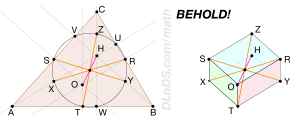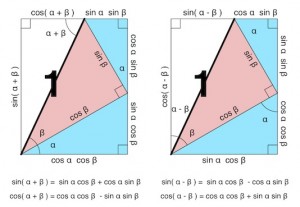The “Nine-Point Circle” of a triangle \(\triangle ABC\) contains the vertices of the medial triangle (\(\triangle RST \)) and orthic triangle (\(\triangle UVW \)), as well as points \(X\), \(Y\), \(Z\) that bisect segments from \(\triangle ABC\)’s orthocenter (\(H\)) to its vertices.
A question on Math.StackExchange.com asked for proof that the center of the nine-point circle bisects the segment joining orthocenter \(H\) and circumcenter \(O\). I thought I’d post my answer here.


claimtoken-51808748be339
A question at Math.StackExchange asked about “Ceva’s Theorem in three dimensions”.
So I derived one.
The result (which I believe may be new, although it could very well exist in the hundreds of years of mathematical literature since Ceva) replaces the traditional ratios of segment lengths with “triple-ratios” of triangle areas, to satisfying effect. Whereas the ratios in Ceva’s Theorem reduce to \(1\) (or “\([1:1]\)”), my triple-ratios reduce to \([1:1:1]\).
I like the result enough that I’ve tidied the derivation, added a smidgeon of context, and touched-on the (current) lack of a corresponding Menelaus-like theorem. See my note: “A Ceva-like Theorem for Tetrahedra” (PDF).
One of my favorite images:

I have updated my note, “Hedronometric Formulas for a Hyperbolic Tetrahedron” (PDF), with a brand new formula for the volume of an arbitrary tetrahedron in terms of its face and pseudo-face areas. (See Section 8.3.)
The formula isn’t the monolithic and symmetric counterpart to Derevnin-Mednykh I’ve been seeking, but it’s a start. It’s complicated enough that I won’t attempt to render it here.
The Open Question: As one might expect, the formula involves an integral. One of the limits of integration is the subject of a Conjecture. Again, the notion is too complicated to describe here, but the gist is that I *believe* that, by appropriately assigning names to the faces (and pseudo-faces), we guarantee that the lower limit is simply one-quarter of a particular pseudo-face area. (If I’m mistaken, then that limit is a less-obvious root of a trigonometric equation.) Numerical experiments in Mathematica suggest that the conjecture is true, but I don’t have even non-constructive proof. (Nevermind that the conjecture wouldn’t really be helpful without a practical way to determine what an “appropriate assignment” of names would be.) When (if?) a properly symmetric formula is finally discovered, the order of face names won’t matter at all; but for now, it makes for an irksome little wrinkle in the formula.


